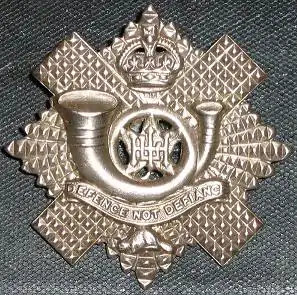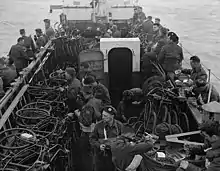Highland Light Infantry of Canada
The Highland Light Infantry of Canada was an infantry regiment of the Canadian Army. In 1965, the regiment was amalgamated with The Scots Fusiliers of Canada to form The Highland Fusiliers of Canada (now The Royal Highland Fusiliers of Canada).[1][2][3][4]
The Highland Light Infantry of Canada
 | |
|---|---|
| Active | 1886–1954, 1957–1965 |
| Country | |
| Branch | Canadian Militia (1886-1940) Canadian Army (1940-1954, 1957-1965) |
| Type | Line Infantry |
| Role | Infantry |
| Size | One battalion |
| Part of | Non-Permanent Active Militia (1886-1940) Royal Canadian Infantry Corps (1942-1954, 1957-1965) |
| Garrison/HQ | Galt, Ontario |
| Motto(s) | Defence Not Defiance |
| Colors | Facing colour buff |
| March | Quick - Sean Triubhas (Whistle o'er the Lave o't) |
| Engagements | First World War Second World War |
| Commanders | |
| Notable commanders | Harry Wickwire Foster |
| Insignia | |
| Tartan | MacKenzie |
History
Founded in 1886 as the 29th Waterloo Battalion of Infantry it went through several name changes including, in 1900, the 29th Waterloo Regiment and in 1915, the 29th Regiment (Highland Light Infantry of Canada). It acquired its present title in 1920. In 1954, as a result of the Kennedy Report on the Reserve Army, this regiment was amalgamated with The Perth Regiment to form The Perth and Waterloo Regiment (Highland Light Infantry of Canada). However, this amalgamation was undone in 1957 and the Highland Light Infantry of Canada resumed its regimental identity. In 1965 it amalgamated with the Scots Fusiliers of Canada and was renamed the Highland Fusiliers of Canada.[1][2]
The Highland Light Infantry of Canada held its final order of precedence as 17.[4]
Alliances
The Highland Light Infantry of Canada was allied to the Highland Light Infantry (City of Glasgow Regiment).[4]
Uniform
They were initially kitted with a green Glengarry, trews and scarlet doublet, but became kilted in 1935. Pipers and bandsmen wore a feather bonnet, red hackle, black sporran with three white points, MacKenzie hose for the pipers and red and white for the regiment, and a blue Balmoral bonnet with a diced border, green tourie and red and white hackle.[4]
Perpetuations
The regiment perpetuated the following units:
Battle honours

Battle honours in small capitals are awarded for participation in large operations and campaigns, while those in lowercase indicate honours granted for more specific battles. Battle honours in bold type are authorized to be emblazoned on regimental colours.
The Great War
- Mount Sorrel
- Somme, 1916
- Arras, 1917, '18
- Hill 70
- Ypres, 1917
- Amiens
- Hindenburg Line
- Pursuit to Mons
The Second World War
- Normandy Landing
- Caen
- The Orne (Buron)
- Bourguébus Ridge
- Faubourg de Vaucelles
- Falaise
- The Laison
- Chambois
- Boulogne, 1944
- Calais, 1944
- The Scheldt
- Savojaards Platt
- Breskens Pocket
- The Rhineland
- Waal Flats
- The Hochwald
- The Rhine
- Zutphen
- Leer
- North-West Europe, 1944-1945
Bibliography
- Barnes, RM, The Uniforms and History of the Scottish Regiments, London, Sphere Books Limited, 1972.
- Bartlett, Jack Fortune "1st Battalion the Highland Light Infantry of Canada, 1940-1945" 1951
References
- "Guide to Sources Relating to the Canadian Militia (Infantry, Cavalry, Armored)" (PDF). Library and Archives Canada.
{{cite web}}: CS1 maint: url-status (link) - Defence, National (6 November 2018). "The Royal Highland Fusiliers of Canada". www.canada.ca. Retrieved 29 December 2021.
- "The Highland Light Infantry of Canada". 31 October 2007. Archived from the original on 31 October 2007. Retrieved 3 January 2022.
- Barnes, Major R.M. (1972). The Uniforms and History of the Scottish Regiments. London: Sphere Books Limited.